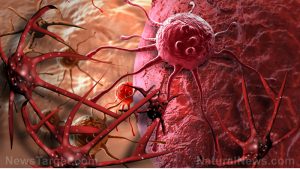
Angiosarcoma – causes, side effects and treatments at NaturalPedia.com
Wednesday, January 03, 2018 by Ralph Flores
http://www.naturalpedia.com/angiosarcoma-causes-side-effects-and-treatments-at-naturalpedia-com.html

Angiosarcoma is a type of tissue cancer (sarcoma) that occurs in blood vessel linings. This kind of cancer “tends to be aggressive, recur locally, and spread widely.” There are two main types of this disease: hemangiosarcomas (sarcomas that start in blood vessel walls) and lymphangiosarcomas (sarcomas that begin in lymph vessel walls). Angiosarcoma can develop rapidly and is very difficult to treat.
Known side effects of angiosarcoma
Some risk factors in the development of angiosarcoma include lymphedema (an impaired flow of the lymphatic system, usually caused by breast cancer treatment), radiotherapy, retention of a foreign material (like steel and plastic) in the body for prolonged periods, and exposure to chemical hazards (like arsenic and vinyl chloride).
What makes angiosarcoma difficult to treat is that it does not have symptoms for its initial stages. Signs of the disease tend to occur when cancer is already at an advanced stage, or when it has begun spreading to other parts of the body.
An angiosarcoma may look like an infection, lesion, or a stain on the body part that it has affected. A mass of soft tissue can also be found in the area. Symptoms such as anemia, hepatic dysfunction, bleeding, and pain may also indicate the presence of angiosarcoma.
For angiosarcoma in the breast, other symptoms would include a variation in the shape and size of the breast, a change in the shape of the nipple as well as rashes on or around the area, and fluid discharge.
Body systems harmed by angiosarcoma
This type of cancer is known to spread from one area to another aggressively; therefore, it has the potential to affect multiple systems in the body directly. Some areas that angiosarcoma commonly affects are soft tissue, the skin, bones, breast, as well as the lungs and the liver. There have been reported cases of angiosarcoma in the spleen, small intestines, and the ovary.
Food items that may prevent angiosarcoma
The risk of developing angiosarcoma may be reduced by consuming the following foods:
- Raw garlic – Garlic is known to boost immunity, lower blood pressure and cholesterol levels, and function as a natural detoxifier – mainly because it contains powerful antioxidants that remove free radicals from the system.
- Broccoli – This vegetable is high levels of phytochemicals, as well as the antioxidants glucoraphanin and indole-3-carbinol, which reduces the risk of cancer. Aside from these benefits, broccoli contains a lot of nutrients (with no calories) and is best eaten raw or blanched.
- Green tea – Experts have reported that drinking green tea may help naturally prevent cancer. The beverage also has catechins, which are said to be better than vitamin C in combating free radicals.
- Strawberries – While strawberries aren’t actual berries, they still help slow down cancer cell growth, as well as protect your body from heart disease, prevent memory loss, and lower inflammation.
- Spinach – The vegetable not only has low calories, but it is also rich in folate and fiber, which are believed to keep cancer at bay. They also have omega-3 fatty acids that the body needs.
- Tomatoes – Lycopene, the well-known antioxidant that makes it red, is believed to prevent certain cancers from developing. Cooked tomatoes have higher levels of lycopene, as these are released when tomatoes are cooked.
- Carrots – Aside from beta-carotene, which helps the body prevent cell damage and suppress cancer cells, carrots also contain falcarinol and falcarindiol which can also help fight cancer.
Treatments, management plans for angiosarcoma
The normal courses of treatment for angiosarcoma are chemotherapy and radiotherapy, aside from medication. Some treatments include:
- Surgery – Physicians consider excising the cancerous growth from the body as the primary treatment method. Depending on the case, it may result in the removal of tissue mass, the breast region (if it is a mastectomy), or even amputation.
- Neo-adjuvant therapy – This term includes radiation treatment and chemical treatment (chemotherapy) to destroy cancer cells. Radiation levels and drug dosage will vary depending on the progression of the disease and may be done before and after the surgery.
Where to learn more
Summary
Angiosarcoma is a type of cancer that is found in blood vessel linings. Once it develops, it can spread to other regions. Moreover, symptoms appear at advanced stages and can prove to be difficult to address. Still, there are foods that can be consumed to prevent the onset of angiosarcoma.
Sources include:
Tagged Under: Tags: angiosarcoma






